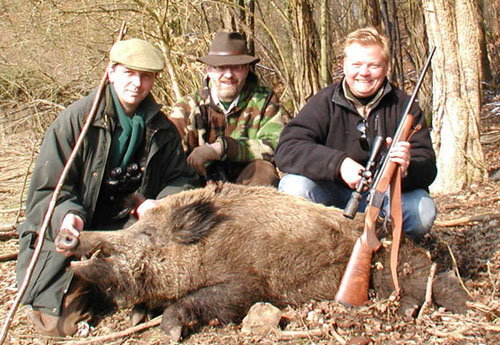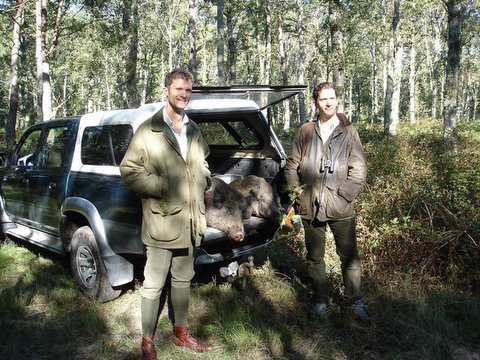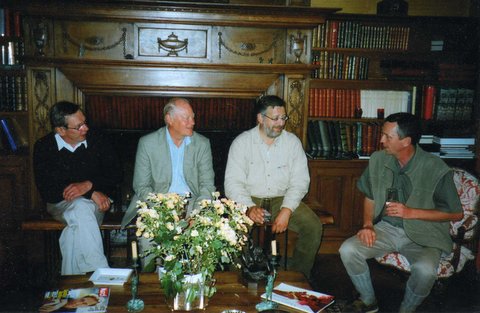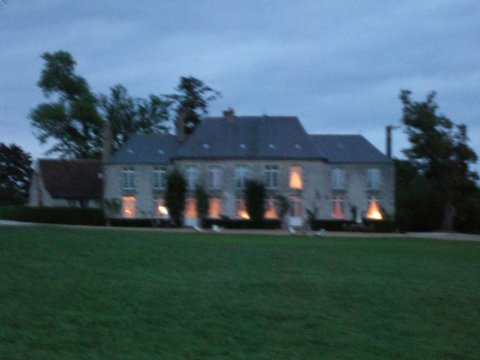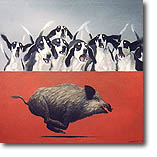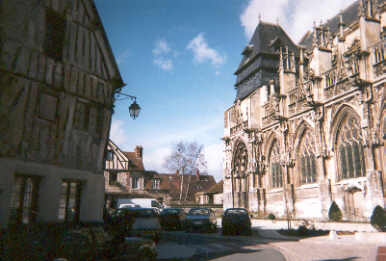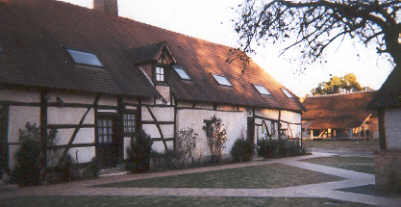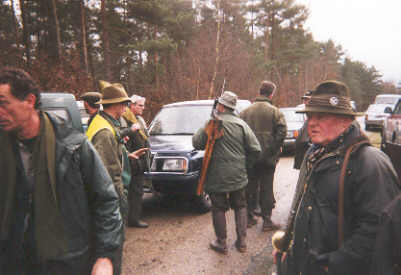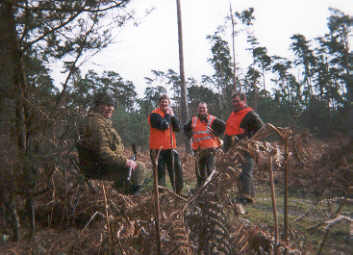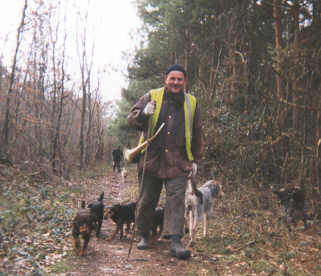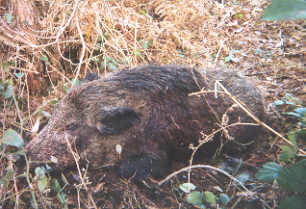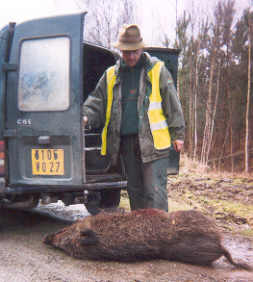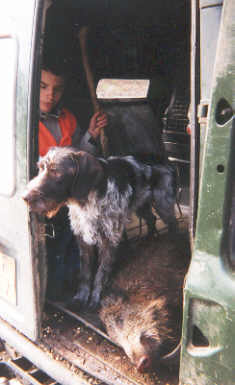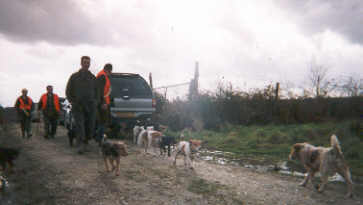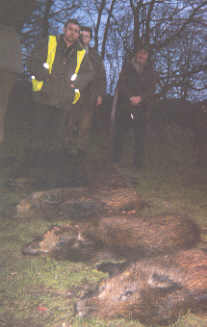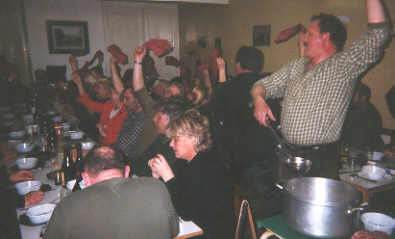| Hunting
contents Homepage Contact |
HUNTING IN FRANCE Wild boar - Sanglier Season Stalking Driven
An exceptional wild boar result of a great morning's winter stalking Prices Please contact
us by email to receive an offer. Species Sus scrofa
only (sanglier). Regions We are mostly hunting in Normandy & Sologne, within a couple of hours from Paris, but wild boar is present everywhere in France. We also arrange shoots near Bordeaux and in eastern France in the Champagne region reputed for the beauty of the deep forests and the quality of the hunts. The scrub hills of Provence offer a wonderful setting for hound driven hunts.
Boar hunting in France from the sunny days of the late summer to the snows of February...
Late August, successful early morning stalking in the Sologne region
A deserved breakfast is served afield Before going back to the lodge September, hound driven day in Normandy One boar to record after the first drive A "hunting pow wow" is held afield in the country of Normandy
But still, there will be plenty of stories and theories to tell...
Early October, the opening day of our family hunt has produced a nice stag and a boar (five others have been missed) Colder days have come The hounds (griffons nivernais) are ready But some will fall A nice winter day's result. Honor salute with the French hunting horn. Followed by a warn lunch at the "rendez vous". * * - Readings - Boar hunting "chapels" in Europe
As an occasional advertiser in Gray's for Gourmetfly.com, I sometimes receive the magazine which I like a lot. I really appreciated your article about boar hunting in the USA. Your writings inspired me this report on boar hunting habits in Europe There are 3 main different "chapels" and different styles of hunting: The German, the French, and the Spanish ...
Boars in Europe are considered as game since the very beginning of
mankind. Writing game, I mean game in all the very technical senses
this word may express. More precisely, I would say that boars are
appreciated for their ability to hide or escape, for the thousand
difficulties man or dog may have to find it and catch it, for the skill
and experience required, but never ever for the violent aspect of the
hunt or boar's ability to fight. Boar is game and only think of
escaping, and does it with talent, any kind of fight is an accident.
Even in close contact, boar is feared but not even as much as the stag
following the old hunter's saying: "Au sanglier la civière, au
cerf la bière..." This means that the boar sends you back home
on a "hand barrow" when the stag would dispatch you in a coffin !"
The German tradition.
This is the way boar is hunted from central Europe like Hungary, Poland, Bulgaria and so forth, to Germany, and even Belgium and the northeastern parts of France. There are two ways: One for groups, and one for individuals aiming more to trophy. The group hunt "Drücken", is a drive conducted by people and short range dogs like the very appreciated small brave one called Jagd terrier (Jagd simply means "hunt"). It is usually a "silent" drive where beaters slowly push boars out of the "ring". The intention is to push beasts to slowly pass lines allowing guns to carefully choose the quarry and possibly place good bullets. Of course rifles are used in gauges similar as for deer. Another dog is used for the case that bullet was not so well placed and is called something like "blood hound" in German the most famous is the one from Bayern we call it in France le "Rouge de Bavière", (the red from Bayern), these dogs are specialized on "cold" tracks and "blood drops followings" they are required to trace and find (usually late after the hunt), any wounded game. They can eventually put the animal at bay or/and bark but again their main talent is on cold tracks and animal dead already since a serious while. The land for both these hunts is a huge dark forest with old tall pines but not so much covert on the ground. So game is very "mobile" there and the trick is to place guns in a way that do not, as we say here "put animals on feet". The individual German way of hunting is a stalking but more often a wait at a strategic feeding or water place, waiting for pray on a man made platform or high seat, (hochsitz). The hochsitz is a simple log ladder with a more or less comfortable seat on top. During the winter it requires a really good polar equipment and a nice flask of schnapps ! This technique is also used during the summer and allows shooter to precisely choose the pray usually shot for two reasons: 1/ Eliminate undesired subjects and 2/ Harvest highly desired trophies. This technique is used for the 3 species as stags, roebucks and boars. German type boars are bigger than in the southern Europe, and the more you go East, the bigger boars are and the better trophies you may find, though as you were pointing out in your article, quality of trophy is not necessarily linked to weight. In southern Europe, around 200 lbs will be considered very big when in eastern Europe you may find up to 400, and even 800 lbs boars. The French tradition.
French tradition is divided in different aspects. (We could even say 3 traditions as north-east as we have seen is following the German school). The center of France is a landscape of cereal fields and rather flat forests planted of mixed species like, oaks, beeches, aspens, pines, chestnuts. The ground is providing very bushy covert of young trees and brooms, brambles, and ferns or usually all mixed together with sometimes hollies. The traditional boar hunt, "La Battue", is a friendly and messy reunion of guns, beaters and dogs of all kinds. It is a noisy beat, where the difficulty also is to take position without chasing boars away before beginning of the hunt, but also this time the difficulty will be to push the animals out of the thick covert. This explains the noisy beaters and dogs of all hair !  Rifles now have replaced shotguns in most of these hunts but when I was young the traditional ammunition were buckshot or BB's in association with a slug. Geographically, this is also the area of the very traditional hunt with pack of hounds, horns and horses and the famous old fashioned red, green or blue coats that you also mention in your article. I am sorry and hope I will not disappoint you but the kind of "pig sticking" you evoke, (and I see very well what you mean as it made me dream when I was a kid and saw the "The three lancers of Bengal.."), well this hunt never existed here nor in Spain and I doubt anywhere around, for the simple reason that no one can ride a horse in the coverts usually used by our friend sus scrofa. The hunt with hounds is called "La Chasse à Courre" and is based on the same principle as the better known "fox hunt" in the Anglo Saxon world. The goal is to "take" an animal from beginning to end with the only skill of your pack. The trick being that the pack must be able to resist to change and must not switch to a fresh quarry during the hunt otherwise obviously you will have to play the hated Rosalie, "missed retreat" with your sad horn. Boar hounds are tall, fast and strong dogs. The first difficult step is to shorten distance between the "foot" found early morning and turn it into hunting of real boar. A limited pack of maybe 6 or 10 skilled dogs is used for this. It is called "rapprocher", (bring pack closer to the beast), this maybe is the most difficult part of the hunt. Hunted boars are usually going straight and fast, its scent is good but light, it will use many obstacles like deep covert and water but will usually tend to use distance and endurance more than tricks to escape the hunt. The change of forest is very common. Unexperimented young dogs may follow another boar but boar itself will not or rarely on purpose use the trick called "change" consisting in bringing pack to another animal. At the end of the hunt during the part called "ferme" (firm), or "ferme roulant", (rolling firm), just before being put at bay, the boar will choose a thick covert and turn around inside it giving difficulties to the tall dogs. It may also choose water like pond, river or swamp. It is said that a boar managing to "empty and wet dirt himself in a swamp" (se vider et se souiller), during the hunt will escape quite surely. This means that once the actual hunt has begun, a continuous pressure has to be maintained by the pack otherwise it is likely to loose it's prey. In the ancient tradition of the Chasse à Courre or Vénerie as we call it also, many tricks have been used to shorten the hunt and the main reason was that using no vans and lorries and only torches if the hunt was taking you a bit too far and the night was there very early in rainy gloomy winter days, the "retreat" through forest at night back to castle or house, was likely to be very unpleasant. In our lands the idea of camping in the woods stopped to be a habit around the 1st century. Among those tricks were first the use of bows and arrows and big dogs like mastiffs or fast dogs like sort of strong greyhounds. These were in fact used like guns, as someone would go well ahead the hunt on potential escaping way of the prey, unleashing dogs "at sight" only. dispatching boar then was done with a short lance or with a strong dagger. This was done at bay, usually the boar being held "aux écoutes" (the ears), by the mastiffs. never ever a boar was or is stabbed from a horse, but always by a walking man. Dogs of the pack always were bred to avoid physical contact at bay. Those who are too "brave" do not last a long time. Only bark and cut retreat. With the invention of firearms, the mastiffs gradually disappeared. Today is done absolutely the same but no mastiff and no firearms are involved. A boar is chosen early morning according to his "foot". Then "attacked", and hunted until put at bay. Riders are following or preceding and whitness the exits. The horns are used like talkie walkies sending general informations to everybody like "change of forest", or "tally ho's". As well horns are a tool along with whips to "drive the pack". The whip stops "cadet hounds" lost or confused on some other prey, and horns rally pack on the "hunted animal" when needed. When at bay, the pig is usually dispatched with a dagger or a boar spear, or even sometimes with a slug, shot by a very short single barrel shotgun. Shorten or stop any fight and avoiding dog wounds, is a priority. You may find interesting to have a look at the website of the French Vénerie http://www.venerie.org Trophy at this hunt is a happy accident. What is searched in priority is to obtain a pack working like a swiss watch ! The third way to hunt boars, "La Chasse aux chiens Courants", is found in the southern part of France and is a hybrid of beat and Vénerie. Landscape has changed and our forests and fields have been replaced by vast hills and bushy scrublands. Boars in these hills have decreased in size and weight but are turned into very fast, wild and agile animals. In the most sloppy and rocky places these boars would beat any mountain goat. They climb vertical rock walls without a problem and they are very wild. So the typical hunt would be as follows: a group of 10 to 15 hunters will select a ring of about 1000 ha for the day. All guns will depart and choose strategic passes. Meantime the dog master will go inside "ring" with dogs on the leash and will try to find a fresh enough "foot", usually called literally, a "foot of the night". (I am not saying footprint as "foot", is just the translation of the colloquial French expression). During that, the guns are waiting, and it can be quite a long wait. Then, lets say master has found something interesting. He has his best dog (sleuth hound), on the leash and one or two assistants (piqueux) will have the rest of a limited pack of 5 or 6 hounds. (The riding Vénerie uses packs of 40 or 50, but technique is the same. 1st find an "animal de chasse" with the "limier", sleuth hound, approach beast with 5 or 6 experimented "rapprocheurs" dogs, then launch rest of pack). An interesting "foot" is found. As I said, it is not a footprint as sometimes, ground is very dry and nothing is visible. For a while master will follow with hound on the leash. More serious is the foot, more the dog will pull the leash (the risk is of course to follow this foot reverse way or upstream !). After some distance like this, the dog will start confirming by pulling more or with voice, that he wants this hunt. He is unleashed. A short while is waited to see if he goes straight with good mood and starts giving voice in a satisfactory way. If yes then the pack is unleashed and they go straight to the first hound and start hunting. The master will continue the hunt following and sometimes pushing or helping the dogs. He sometimes shoots at bay but most usually these boars are "light" and will run as soon as they know they have a hound "behind". But "behind" quite often means well behind as the "foot" found may be 3 or 4 hours old when the hunt begins. then if boars are "launched", all guns hide silent and listen to bells and barkings. These dogs carry a nice sounding bell (la cascarre or campane), easy to hear in these valleys even within rather important distance. Following the hunt this way, so alone and quiet in the big scented circle of bushy hills is a wonderful pleasure. (For patient hunters only... ! those who prefer to sweat and run will go along as piqueux with the master). The main difference with the Vénerie is the limited number of dogs out. (Masters usually own around 20 or 25 but take only 5 or 6 everyday). These people are usually paysants, not too busy during the winter and if they don't hunt everyday, it may well be 5 or 6 days a week !. (As an example I have friends in Provence doing this, they go out like 5 days a week minimum from late August till early January and this year they killed 140 boars). another difference with the Vénerie is that guns don't pay attention to who is the main hunted beast. Any boar crossing line at a pass is shot. It might be contradictory for 10 or 15 guns controlling around 1000 ha of hills, but rifles are almost never used and boars are shot with slugs, (it used to be with buckshots and BB's etc.. but they're now forbidden). The "drives" of Northern France involve 30 guns for like 50 or 100 ha beaten, and they use rifles. The trick for boar hunting in these hills is to perfectly know passes in the scrubland. Boars are shot at very short range and sometimes require snapshot as it will not be visible for a long time. The breeds for Vénerie are classified in a category called "chiens d'ordre", (dogs of order), they usually bear names of the old regions of origin like Poitevin, Normands or Saintongeois, sometimes they show the ancient mixture of two origins like Gascon-Saintongeois or Anglo-Poitevin, or sometimes it just indicates size and color as Grand chiens français noir et blanc or Anglo français tricolore de petite vénerie. They are all "short hair, long ears". The other hunt described with hounds & shotguns, la "chasse aux chiens courants", (running dogs hunt), uses dogs featuring same "nose" and voice qualities, but more independent and difficult to keep in big packs. Breeds are often griffonées from the name griffon, mixture of a short hair hound and a griffon. Like Griffon bleu de Gascogne. Griffons are dogs of longer wired, "shaggy" or "woolly" hair and moustache. Griffon nivernais, Griffon vendéen, Griffon fauve de Bretagne. Same breeds often have a basset type for hare or rabbit, but sometimes used on boar on less vast areas. The hunt described above is quite current in Spain as it is also in Italy, Greece and Corsica, but Spain has a more specific modality. The Spanish tradition.
Hemingway could have described the boar hunts as a movable feast as we are now heading South to Spain for another fiesta called: La Monteria. Apparently, the Monteria has to see with the Vénerie as it involves big packs of hounds and horses, daggers and horns (in fact the brassy horns are replaced by the "caracola", a big seashell in which professional hunters blow for rappel). And dog masters are dressed in the ancient tradition with rawhide boots and beautiful leather leggins. The pack is often involving 40 or 50 dogs or even more. It is mainly composed of an ancient breed cousin to greyhound but much stronger, called "podenco". It recalls the Irish or Scottish wolfhound though it is smaller in size, but still it's a big dog weighing around 70lbs. Color is mainly white with chamois or golden stains. It is rather "hairy", some griffon must have been somewhere in the original blood. They are fast and strong dogs the "nose" and the voice is not given such importance as in France. Actually it is a totally different hunt. These dogs are "fast beaters". They push everything and push it quickly. they're not supposed to follow tracks a long time and in fact they hunt more like greyhounds emphasizing on the pursuit more or less (as covert is deep), at sight. As they are so fast and strong they will quite often take quickly or put at bay the slowliest animals. Mastiffs (màstin), are used with them and will go to fight in the ancient way "el agarre", dogs take the boar by ears and stabbing with long daggers is just a "formality" when the perrero arrives, sometimes on a horse or a mule, sometimes walking. "Perrero" is the name of the dog "conductor" (perro means "dog" in Spanish). He is an independent professional, not linked to any hunt. He is just hired here and there along season. The Monteria aims at both deers and boars and sometimes other game like wild goats or roebucks. It is the Spanish "driven big game mixed shooting" Hunters want numbers and trophy. Principle is rather simple. A huge estate of bushy hills is divided in 3 or 4 areas usually full valleys. This valley is kept quiet for 3 or 4 years to leave time for game to multiply and trophy carriers to get older. Then one single monteria is organized during season. Guns are approx 35 or 40 sometimes more. They are placed at butts top hill surrounding valley. The podencos will push all game out. Every animal passing line is shot or at least tried exactly like red legged partridge during a drive at Valdepeñas or Toledo. Of course rifles only are used in these shoots. 80 or 90 animals killed like 50 deers and 40 boars is a quite common result. All the best. / Nick
or
a lodge in the forests of Sologne Then:
En forêt ! The lines will take position
Beaters in discussion with a rifle
Le Piqueux and his Jagd terriers
A good boar
Heavy beast to load in the car
Young beater, young drahthaar, young boar
The
road home Weighing over 200lbs
Le tableau de chasse And the traditional dinner party ?
In fact it is the closing days dinner party * |
